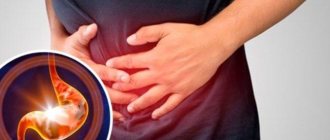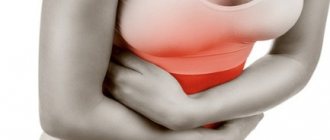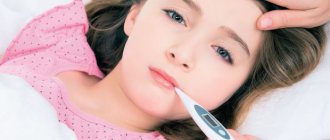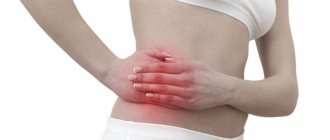In the autumn-winter period, in addition to influenza and acute respiratory viral infections (ARVI), rotavirus infection is widespread. According to doctors, recently it has become all-season. At first, the disease can be mistaken for a cold (ARVI) or flu, but vomiting, diarrhea, and abdominal pain are added to the typical cold symptoms.
It is very easy to become infected with rotavirus, since the infection is transmitted by contact: through dirty hands, door handles, handrails and toys, eating food from the dishes of an infected person, etc. Favorable environments for rotavirus are also crowded places, and children's institutions are located in areas of high risk. Symptoms of a cold and intestinal disorder can also be caused by other viruses at the same time.
Questions and Answers How is rotavirus different from norovirus?
What infections can cause cold symptoms combined with nausea and vomiting?
Once in the human body, rotavirus causes an infectious process, which is characterized by a short incubation period and an acute course. Rotavirus infection is characterized by an acute onset: vomiting, a sharp increase in temperature and diarrhea. These symptoms can also be caused by other enteropathogenic viruses (enterovirus, norovirus, adenovirus, astrovirus). Patients may experience not only impaired gastrointestinal motility, but also, in some cases, dehydration, which is especially dangerous.
A number of other diseases may have similar symptoms. According to general practitioner Irina Yartseva , nausea and vomiting can also occur with the flu. As long-term observations have shown, the largest outbreaks of rotavirus infection occur during or on the eve of an influenza epidemic, for which the disease received the unofficial name “intestinal flu,” although the rotavirus itself has nothing to do with influenza viruses.
Only a specialist can help you distinguish one disease from another. “You won’t realize it’s rotavirus. There is a rapid diagnosis of influenza, it is fast, but expensive. For influenza, a clinical picture is sufficient. There is no seasonality at all for rotavirus; infection occurs all year round. In principle, there is no need to diagnose it. Yes, and ARVI includes about 200 viruses. They all proceed in a similar way and, to one degree or another, have overlapping symptoms that do not require specific treatment,” says the doctor.
When should a sick person see a doctor?
A healthy body can and should overcome a mild ARVI that occurs without serious symptoms in 5–7 days. If within a week the symptoms do not go away or even worsen, we can almost certainly talk about a complication of a seemingly unimportant disease.
The patient may experience symptoms of laryngitis or pharyngitis, tonsillitis, rhinitis, signs of inflammation of the paranasal sinuses - sinusitis or sinusitis, otitis, tracheitis, bronchitis and even pneumonia. In this case, even if the temperature has not risen, you should definitely contact either your family doctor or a good ENT doctor in Moscow.
Doctors include dangerous symptoms:
- difficulty or increased breathing;
- the appearance of wheezing;
- long lasting cough;
- chest pain;
- significant increase in temperature;
- severe pain in the forehead;
- fainting state;
- confused consciousness, inability to navigate in space;
- severe vomiting.
Is there any special treatment for such diseases?
“For influenza, in the first 72 hours you can use several effective drugs that reduce the duration of the disease. And for other viruses there is no specific treatment. Therefore, a clinical picture, observation of how the disease progresses, and an examination by a doctor are sufficient. And with timely symptomatic therapy and compliance with bed rest, complications can be avoided,” says Yartseva. The expert reminds: self-medication is dangerous. “To find out the cause of the disease, you need to go to the doctor. Some people may experience vomiting, while others may have diarrhea. Depending on the symptoms, the doctor will prescribe treatment. The main general recommendations include drinking plenty of fluids,” says the doctor.
Question answer
Does cola help with rotavirus?
Why does cephalalgia develop?
The brain does not have its own pain receptors. The sources of discomfort may be the meninges, cervical vertebrae or other anatomical structures. Often this condition develops in response to physiological changes in distant parts of the body. For example, many women constantly experience cephalalgia during menstruation. Experts believe that certain pathological and physiological changes affect the condition of the blood vessels and sinuses passing through the meninges.
Damage to the endothelial cells lining the inner lining of blood vessels is a well-studied feature of coronavirus. The pathological process leads to a decrease in the vascular lumen and disruption of the blood supply to tissues. If such changes form in the sinuses of the meninges, pain occurs. Corona patients also suffer from inflammation of blood vessels, blood clots and other ailments, accompanied by painful sensations in the head area.
Other reasons
Primary or secondary headaches that develop against the background of coronavirus can be caused by various etiological factors. During the examination, doctors take into account the presence of any chronic diseases manifested by this symptom, since COVID-19 is known for its ability to affect the condition of almost all organs and systems.
Additional causes of cephalalgia:
- the formation of blood clots in people with atherosclerosis and other risk factors;
- exacerbation of symptoms of arterial hypertension;
- changes in vascular tone due to dysregulation of the autonomic nervous system;
- disruption of blood flow to brain cells and the occurrence of hypoxia;
- infectious toxic syndrome;
- taking certain medications to treat covid.
Stress, weakness and other factors provoke attacks of migraines and tension headaches. The presence of high temperature increases the likelihood of primary cephalgia. If your head hurts severely during movements, the cause may be due to an exacerbation of osteochondrosis.
How does the infection occur in adults and children?
Rotavirus infection affects children and adults. But unlike children, rotavirus symptoms in adults are milder. Because rotavirus affects the digestive system, the main symptoms of the disease are vomiting and watery diarrhea. In children, the development of the disease, as a rule, follows this pattern: first, the child is bothered by nausea, then mild pain in the abdomen occurs, after which vomiting begins. Diarrhea can recur 4-5 times a day, but in severe cases it can reach 15-20 times, which can lead to severe dehydration. The child loses a lot of salts with liquid, so the main thing for rotavirus infection is “drinking” with saline solutions.
“Children are more difficult to convince of the need to drink plenty of fluids. It takes a long time to persuade them. But this approach allows you to replenish fluid loss to avoid complications. Adults do not need to be convinced; they clearly follow the doctor’s recommendations about what and how to do,” says Yartseva.
Article on the topic
Beware of rotavirus! Building protection against intestinal flu
Features of the course of ARVI without fever
A respiratory viral infection is localized in the nasopharynx and after a couple of days it manifests itself as a certain discomfort. Following tickling and sneezing, copious watery discharge from the nose appears, which after a couple of days becomes mucous, sometimes mixed with blood and pus.
Medical statistics indicate that the main symptom of ARVI, with or without fever, is a runny nose. Four out of ten patients experience a sore or sore throat, and six out of ten subsequently develop a cough, which has certain characteristics associated with a cold.
Dry and superficial, it is rather a reaction to tickling. But with weak immunity, there is a possibility of it spreading to the upper respiratory tract. Having descended into the trachea and further into the bronchi, the infection can finally cause fever. Although recently there have been frequent cases of bronchitis and pneumonia occurring without a significant increase in temperature. Needless to say, when symptoms of ARVI complications appear in children, they should definitely be shown to a good pediatrician?
If the sick person also suffers from muscle pain and aches throughout the body, then his temperature will probably rise greatly, since in this case, influenza will most likely be diagnosed - the most serious of acute respiratory viral infections.
What should you do if you or your child has rotavirus or a similar infection?
In addition to drinking plenty of fluids, you should follow a diet. From the diet you need to exclude foods that are difficult to digest or irritate the mucous membrane: whole milk, fatty milk, fried, smoked, concentrated juices, fresh fruits and vegetables. Yartseva recommends taking antipyretic drugs only when necessary. “You shouldn’t abuse them. Children should not be given ibuprofen frequently. It cannot be used for a long time and constantly; it must be alternated with paracetamol. If that doesn’t help, you can sometimes add ibuprofen,” says Yartseva.
What to do if you have a headache?
Since this is a characteristic manifestation of coronavirus in most patients, there is no need to panic. Experts advise monitoring your general health, breathing and blood oxygen levels. It is recommended to periodically perform pulse oximetry to determine saturation. If other signs of coronavirus infection are observed, you should call a doctor for a general examination and assessment of the severity of the condition. If necessary, the therapist will prescribe diagnostic procedures or give a referral for hospitalization.
Self-medication for COVID-19 is fraught with dangerous complications. The patient will not be able to independently determine the cause of cephalgia, and without a diagnosis it is impossible to carry out treatment. If the pain quickly intensifies and is accompanied by alarming symptoms, you should immediately call an ambulance. On-site doctors will take the necessary measures to determine the cause of the illness and exclude complications related to Covid.
Diagnostics
A general practitioner examines patients with coronavirus. If necessary, a consultation with a neurologist is scheduled. The specialist collects anamnestic data to evaluate all complaints and determine the severity of the condition. A neurological examination is performed to exclude damage to the central nervous system. Taking into account the results of the examination, instrumental and laboratory research methods are selected.
Types of diagnostic procedures:
- Analyzes. Clinical and biochemical blood tests are necessary to determine the severity of COVID-19 and identify inflammatory complications. A coalogram will show increased blood clotting, predisposing to the formation of thrombosis.
- Computed tomography or magnetic resonance imaging are highly accurate visual research methods. The doctor receives volumetric layer-by-layer images of the brain and other structures, allowing them to detect focal changes. CT and MRI are suitable for diagnosing vascular pathologies.
- Electroencephalography is a method for assessing brain functioning by recording bioelectrical signals. EEG results will show signs of neurological diseases.
- Echoencephalography with Dopplerography to detect vascular pathology of the brain. This is a real-time visual examination that allows you to assess the nature of blood circulation and the condition of the vascular bed in the head area.
- Lumbar puncture is the collection of cerebrospinal fluid from the subarachnoid space using a puncture. The results indicate inflammatory or infectious damage to brain tissue.
Headache does not always require special diagnostic measures. In most cases, an examination and exclusion of Covid-related complications is sufficient.
Prevention
The headache will not occur or will quickly go away on its own if the patient takes preventive measures. During the course of the infectious process, it is important to give up any bad habits that provoke the development of pain. You should not smoke, drink coffee or alcoholic beverages. It is necessary to refrain from physical activity until complete recovery. Increased sleepiness due to coronavirus leads to disruption of the daily routine, so you should try to sleep only at night.
If there is a history of any disease of the cardiovascular or nervous system, treatment should be carried out according to medical prescriptions after infection. Monitoring blood pressure, pulse and saturation will help to detect in time a deterioration in the condition or an exacerbation of an existing pathology. If you detect any dangerous signs, you should immediately seek medical help.
Specialists from the Clinical Institute of the Brain will clarify the cause of cephalgia and carry out the necessary therapeutic measures to eliminate the pathological condition. Our doctors will also select an individual rehabilitation scheme, taking into account the identified complications of coronavirus infection from the central nervous system.











